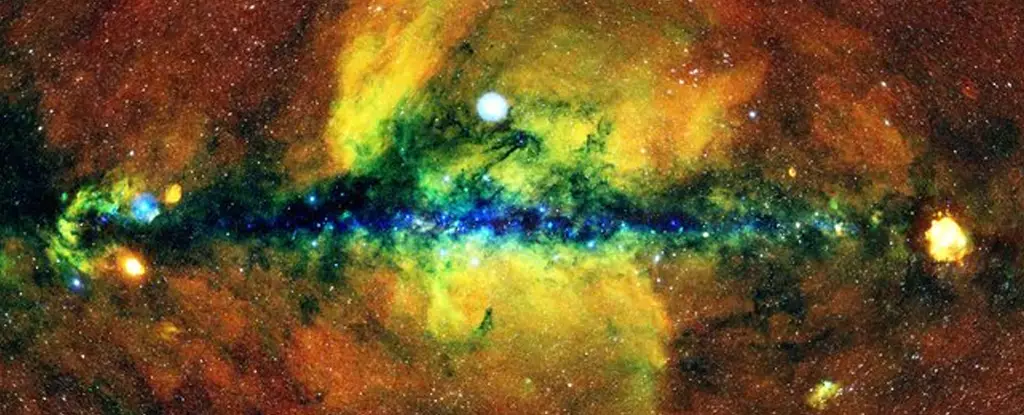The realm of science fiction often teases us with the notion of possessing X-ray vision, the ability to see through solid objects. However, this remains an impossibility for us humans, as our eyes are simply not equipped for such a feat. Nevertheless, scientists have come up with a solution to this challenge that allows us to study the Universe with X-ray vision. This groundbreaking field of study, known as X-ray astronomy, has been in existence for over 60 years and has provided us with invaluable insights into some of the most energetic and violent events and objects in the cosmos.
In a recent announcement, astronomers from the eROSITA consortium at the Max Planck Institute for Extraterrestrial Physics unveiled the latest trove of X-ray data from the eROSITA survey. This survey covers half of the X-ray sky and has revealed crucial information about a staggering 900,000 distinct X-ray sources. To put this into perspective, this surpasses the total number of X-ray sources ever detected in the history of X-ray astronomy, including those discovered by renowned observatories like Chandra.
The eROSITA survey was made possible by the eROSITA telescope, a soft X-ray imaging instrument onboard the Spectrum-RG satellite. Its first all-sky survey, called eRASS1, spanned over 7 months, commencing on December 12, 2019. The telescope detected a remarkable 170 million X-ray photons at its most sensitive setting, allowing for precise measurements of their energies and arrival times. Subsequent scans of the entire sky were conducted between June 2020 and February 2022, resulting in an unprecedented treasure trove of X-ray data that will soon be released.
Hotbeds of Activity
X-ray astronomy is particularly focused on studying hot and energetic objects and events in the Universe. These include the cores of galaxies, where supermassive black holes reside, as well as supernova explosions, newborn stars, and various other regions where matter reaches exceedingly high temperatures. The eRASS1 data set, derived from the preliminary data of the eROSITA survey, has pinpointed approximately 710,000 supermassive black holes, 180,000 X-ray emitting stars within the Milky Way, and 12,000 clusters of galaxies. Additionally, it has shed light on a handful of other extraordinary sources, such as X-ray-emitting binary stars, supernova remnants, and pulsars.
The scale of these discoveries in such a short amount of time is staggering. “We’ve detected more sources in 6 months than the big flagship missions XMM-Newton and Chandra have done in nearly 25 years of operation,” remarks Andrea Merloni, the eROSITA principal investigator and first author of the eROSITA catalog paper.
What makes the eROSITA first data release truly remarkable is its multi-layered approach. By capturing X-ray images at different energy levels, astronomers gain valuable insights into the objects and events emitting these X-rays. In addition to images, the data release also provides information on source classes, sky positions, energies, and precise arrival times of the photons. The eROSITA consortium has prioritized the release of high-quality data and software to expand the horizons of scientists working with high-energy data and push the frontiers of X-ray astronomy.
Unlocking the Secrets of the Universe
The eROSITA telescope has a wide range of scientific objectives, including the detection of the hot intergalactic medium within galaxy clusters and groups. It also focuses on studying hot gas in the filaments that thread through these clusters. Additionally, eROSITA aims to identify accreting black holes hidden within galaxies and investigate the physics of galactic X-ray sources, such as pre-main-sequence stars, supernova remnants, and X-ray binaries.
One of the papers released with the new survey data utilizes X-ray data to constrain cosmological models by studying clusters of galaxies. Notably, the survey revealed a newly discovered filament of material stretching between the galaxy clusters Abell 3667 and Abell 3651. This finding could contribute to our understanding of the “warm-hot intergalactic medium” and the formation of large-scale structures in the Universe. Similarly, the nearby Virgo Cluster of galaxies serves as a valuable subject for studying large-scale filamentary structures and the physical phenomena occurring on the outskirts of these massive galaxy clusters.
The launch of eROSITA in June 2019 marked a significant leap forward in the field of X-ray astronomy. Its high-resolution X-ray vision has enabled groundbreaking discoveries in a relatively short period. It has witnessed changes in a distant quasar called SMSS J114447.77-430859.3, providing insights into the growth of the black hole at its core. The instrument has also detected the formation of a newly forming black hole in the early Universe as well as traced the presence of hot gas surrounding our own Milky Way Galaxy.
As of now, eROSITA is in safe mode, with technicians diligently assessing its health and status. It stands as a testament to our insatiable quest to unravel the mysteries of the Universe through the lens of X-ray astronomy.



Leave a Reply